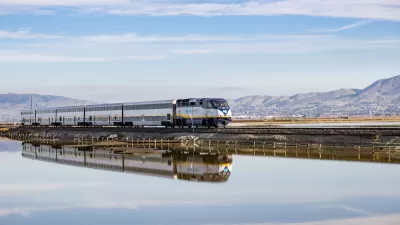Effective planning creates harmonious environments, according to this piece from Xinhua. Most Chinese planners, the author argues, have not embraced this idea.
"The world today is confronted, as we know, with rapid urbanization of poverty and the hazardous impact of climate change. Planning therefore has become an important tool for healthy urban development and environmental management to halt the formation of slums and mitigate hazards."
"In other words, planning is a means to realize the social harmony we have been pursuing."
"Effective planning should steer toward harmonious settlements, putting places in harmony with nature and between people, as the Zhengjiang Communique highlights. It should alleviate poverty and reduce inequality."
"That calls for higher requirements from planners. A qualified planner will have the journalist's capacity to be good at listening to all kinds of views, an economist's capacity to be skilled in calculating the input-output costs, the social worker's capacity to work with the communities, and a politician's capacity to balance various groups' conflicting interests."
"Not many Chinese planners have come to value their profession this way, and the result is dissatisfying urban sprawls featuring inadequate services and inconvenient settings, which are particularly unfavorable to the low-income families."
FULL STORY: It's time to rethink ideas on urban planning

Manufactured Crisis: Losing the Nation’s Largest Source of Unsubsidized Affordable Housing
Manufactured housing communities have long been an affordable housing option for millions of people living in the U.S., but that affordability is disappearing rapidly. How did we get here?

Americans May Be Stuck — But Why?
Americans are moving a lot less than they once did, and that is a problem. While Yoni Applebaum, in his highly-publicized article Stuck, gets the reasons badly wrong, it's still important to ask: why are we moving so much less than before?

Using Old Oil and Gas Wells for Green Energy Storage
Penn State researchers have found that repurposing abandoned oil and gas wells for geothermal-assisted compressed-air energy storage can boost efficiency, reduce environmental risks, and support clean energy and job transitions.

Updating LA’s Tree Rules Could Bring More Shade to Underserved Neighborhoods
A new USC study finds that relaxing Los Angeles’ outdated tree planting guidelines could significantly expand urban tree canopy and reduce shade disparities in lower-income neighborhoods, though infrastructure investments are also needed.

California's Canal Solar Projects Aim to Conserve Resources and Expand Clean Energy
California’s Project Nexus has begun generating electricity from solar panels installed over irrigation canals, with researchers and state agencies exploring statewide expansion to conserve water and boost clean energy production.

HHS Staff Cuts Gut Energy Assistance Program
The full staff of a federal program that distributes heating and cooling assistance for low-income families was laid off, jeopardizing the program’s operations.
Urban Design for Planners 1: Software Tools
This six-course series explores essential urban design concepts using open source software and equips planners with the tools they need to participate fully in the urban design process.
Planning for Universal Design
Learn the tools for implementing Universal Design in planning regulations.
Heyer Gruel & Associates PA
City of Moreno Valley
Institute for Housing and Urban Development Studies (IHS)
City of Grandview
Harvard GSD Executive Education
Salt Lake City
NYU Wagner Graduate School of Public Service
City of Cambridge, Maryland





























